Unit 1: Cells
0.0(0)
Card Sorting
1/88
Study Analytics
Name | Mastery | Learn | Test | Matching | Spaced |
|---|
No study sessions yet.
89 Terms
1
New cards
What is a cell?
A separate living compartment where chemical processes occur
2
New cards
What is the function of the nucleus?
Contains genetic material
Controls cell growth and reproduction
3
New cards
What is the nuclear envelope?
A double membrane that separates the the nucleus from the cytoplasm.
4
New cards
What is the function of the nuclear envelope?
* Helps maintain the shape of the nucleus
* Regulates the flow of molecules into and in and out of the nucleus through nuclear pores
* Regulates the flow of molecules into and in and out of the nucleus through nuclear pores
5
New cards
What is the nuclear envelope attached to?
Endoplasmic reticulum (ER)
6
New cards
What is the function of the smooth ER?
Synthesise lipids which are transported to the golgi apparatus by vesicles.
7
New cards
What is the function of the rough ER?
Protein synthesis
8
New cards
What is the function of the mitochondria?
Aerobic respiration to produce ATP
9
New cards
What is the function of chloroplasts?
Light dependent photosynthesis
10
New cards
What is the function of the golgi apparatus?
* Processes and modifies lipids and proteins from the rough ER
* Makes lysosomes
* Makes lysosomes
11
New cards
What is the function of the nucleolus?
To produce ribosomes
12
New cards
What are plasmids?
Small rings of DNA
13
New cards
What is the function of plasmids, linear chromosomes, looped DNA?
To carry genes
14
New cards
What is the function of the cell surface membrane?
* Hold the cell together
* Control the movement of substances in and out of the cell
* Control the movement of substances in and out of the cell
15
New cards
What is the function of golgi vesicles?
To store lipids and proteins and transport them out of the cell
16
New cards
What is the function of the cell wall?
To protect and support the cell
17
New cards
What is the function of lysosomes?
Contain lytic enzymes to break down cell waste
18
New cards
What is the function of ribsomes?
Protein synthesis
19
New cards
What is the function of vacuole?
* In plant cells they maintain water balance
* In animal cells they store nutrients and waste materials until the cell gets rid of them
* In animal cells they store nutrients and waste materials until the cell gets rid of them
20
New cards
What is the function of the cytoplasm?
Site of metabolic reactions
21
New cards
What is the function of the trans face of the golgi appartatus?
To release the proteins or lipids after package
22
New cards
What is the function of the cis face of the golgi appartatus?
Receives vesicles from the RER
23
New cards
What is the function of the slime capsule?
To protect the cell
24
New cards
What is the function of the flagellum?
Movement
25
New cards
What is exocytosis?
Materials are exported out of the cell
26
New cards
What is the cristae?
Folds in the inner membrane of the mitochondria
27
New cards
What is the function of the cristae?
To increase SA
28
New cards
What is a matrix?
Gel-like material in the mitochondria
29
New cards
What is the function of the matrix?
Contains enzymes involved in respiration
30
New cards
What does specialised mean?
Adapted to perform a specific function
31
New cards
Name an example of a specialised cell
Epithelial cell in the small intestine
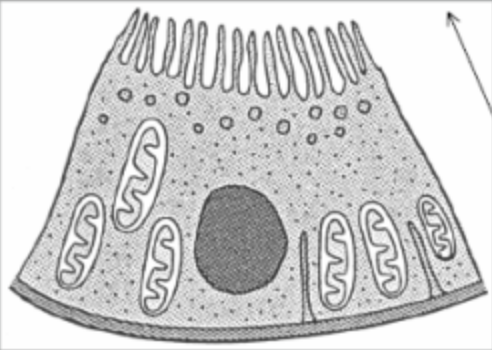
32
New cards
How are epithelial cells in the small intestine specialised for their function?
* Microvilli- increases SA
* Lots of golgi vesicles- to take transport proteins to the cell surface membrane
* Lots of mitochondria- to provide energy (ATP) for active transport
* Lots of golgi vesicles- to take transport proteins to the cell surface membrane
* Lots of mitochondria- to provide energy (ATP) for active transport
33
New cards
What are eukaryotic cells?
Cells with a nucleus
* Multi cellular organisms e.g plants, animals, fungi, protists.
* Multi cellular organisms e.g plants, animals, fungi, protists.
34
New cards
What are prokaryotic cells?
Cells without a nucleus
* Single-celled organisms e.g fungi.
* Single-celled organisms e.g fungi.
35
New cards
What are some differences between prokaryotic and eukaryotic cells?
* Eukaryotic cells have membrane bound organelles whereas prokaryotic cells do not
* Eukaryotic cells have bigger ribsomes than prokaryotic cells
* Eukaryotic cells have linear DNA bound in a nucleus but in prokaryotic cells it is free floating as circular plasmid DNA or chromosomal DNA
* Prokaryotic cells are much smaller than eukaryotic cells
* Prokaryotic cells are single-celled while eukaryotic cells can be multi cellular
* Prokaryotic cell wall is made of murein whereas the eukaryotic cell wall is made of cellulose
* Prokaryotic cells have a flagella but eukaryotic cells only have it sometimes
* Prokaryotic cells have pili but eukaryotic cells do not
* Eukaryotic cells have bigger ribsomes than prokaryotic cells
* Eukaryotic cells have linear DNA bound in a nucleus but in prokaryotic cells it is free floating as circular plasmid DNA or chromosomal DNA
* Prokaryotic cells are much smaller than eukaryotic cells
* Prokaryotic cells are single-celled while eukaryotic cells can be multi cellular
* Prokaryotic cell wall is made of murein whereas the eukaryotic cell wall is made of cellulose
* Prokaryotic cells have a flagella but eukaryotic cells only have it sometimes
* Prokaryotic cells have pili but eukaryotic cells do not
36
New cards
What is magnification?
The process of enlarging the physical appearance/image of something
37
New cards
What is the maximum magnification of a light microscope?
x1500
38
New cards
What are the two lenses on a microscope?
Objective lens and eyepiece lens
39
New cards
How do you find the total magnification?
Magnification of the objective lens x magnification of the eyepiece lens
40
New cards
What is resolution?
The ability to distinguish between two points as separate structures
41
New cards
Magnification equation
Magnification = image size ÷ actual size
42
New cards
What are the two types of microscope?
Optical (light) and electron
43
New cards
What are the two types of electron microscope?
Transmission and scanning
44
New cards
Compare optical and electron microscopes
* Optical microscopes have a low resolution/magnification whereas electron microscopes have high resolution/magnification
* Optical microscopes produce coloured images while electron microscopes produce black and white images
* Optical microscopes can use living specimens (to view life processes like mitosis) whereas electron microscope specimens must be dead since they need to be in a vacuum
* Electron microscopes produce artefacts but optical microscopes do not
* Optical microscopes produce coloured images while electron microscopes produce black and white images
* Optical microscopes can use living specimens (to view life processes like mitosis) whereas electron microscope specimens must be dead since they need to be in a vacuum
* Electron microscopes produce artefacts but optical microscopes do not
45
New cards
What are artefacts?
False objects mistaken for real features
46
New cards
Why does an electron microscope have a high resolution?
Because electrons have a short wavelength compared to light waves
47
New cards
Compare SEMs and TEMs
* SEMs produce a 3D surface image whereas TEMs produce a 2D internal image
* TEMs require a thin specimen but SEMs do not
* SEMs have a low magnification and resolution whereas TEMs have a very high magnification and resolution
* TEMs require a thin specimen but SEMs do not
* SEMs have a low magnification and resolution whereas TEMs have a very high magnification and resolution
48
New cards
What is differentiation?
Making cells adapted to carry out a particular function/job
49
New cards
What is a tissue?
Group of cells
50
New cards
What is an organ?
Group of tissues
51
New cards
What is an organ system?
Group of organs
52
New cards
What is an organism?
Group of organ systems
53
New cards
How does cell fractionation separate organelles?
Density
54
New cards
What are the 3 stages of cell fractionation?
1. Homogenisation
2. Filtration
3. Differential centrifugation
55
New cards
What is homogenisation?
The breaking up of cells
56
New cards
What happens during homogenisation?
The sample is homogenised using a homogeniser (blender) to break up the cell
57
New cards
What 3 conditions must be sample be?
1. Ice cold
2. Isotonic
3. pH buffered
58
New cards
Why must the sample be ice cold?
To reduce enzyme activity
59
New cards
Why must the sample be isotonic?
To prevent osmosis from happening, so osmotic lysis doesn’t occur
60
New cards
Why must the sample be pH buffered?
To avoid damaging protein structures
61
New cards
What happens during filtration?
The homogenate is filtered into tubes through a gauze to remove debris
62
New cards
What happens during differential centrifugation?
* Sample is spun at a low speed to separate it into fractions
* The organelles form a pellet at the bottom of the tube, leaving the supernatant (liquid)
* The supernatant is centrifuged at gradually increasing speeds to separate the least organelles
* The organelles form a pellet at the bottom of the tube, leaving the supernatant (liquid)
* The supernatant is centrifuged at gradually increasing speeds to separate the least organelles
63
New cards
What density are the organelles separated at a low speed?
Very dense
64
New cards
What density are the organelles separated at a high speed?
Not very dense
65
New cards
Order the organelles from most to least dense
Nucleus
Chloroplasts
Mitochondria
Lysosomes
Endoplasmic reticulum
Ribosomes
Chloroplasts
Mitochondria
Lysosomes
Endoplasmic reticulum
Ribosomes
66
New cards
How do prokaryotes reproduce?
Binary fission
67
New cards
Describe the process of binary fission
1. Circular DNA and plasmids replicate
2. Cell gets bigger and the circular DNA strands move to opposite poles of the cell
3. Cytoplasm begins to divide and new cell walls begin to form
4. Cytoplasm divides and two new identical daughter cells are produced
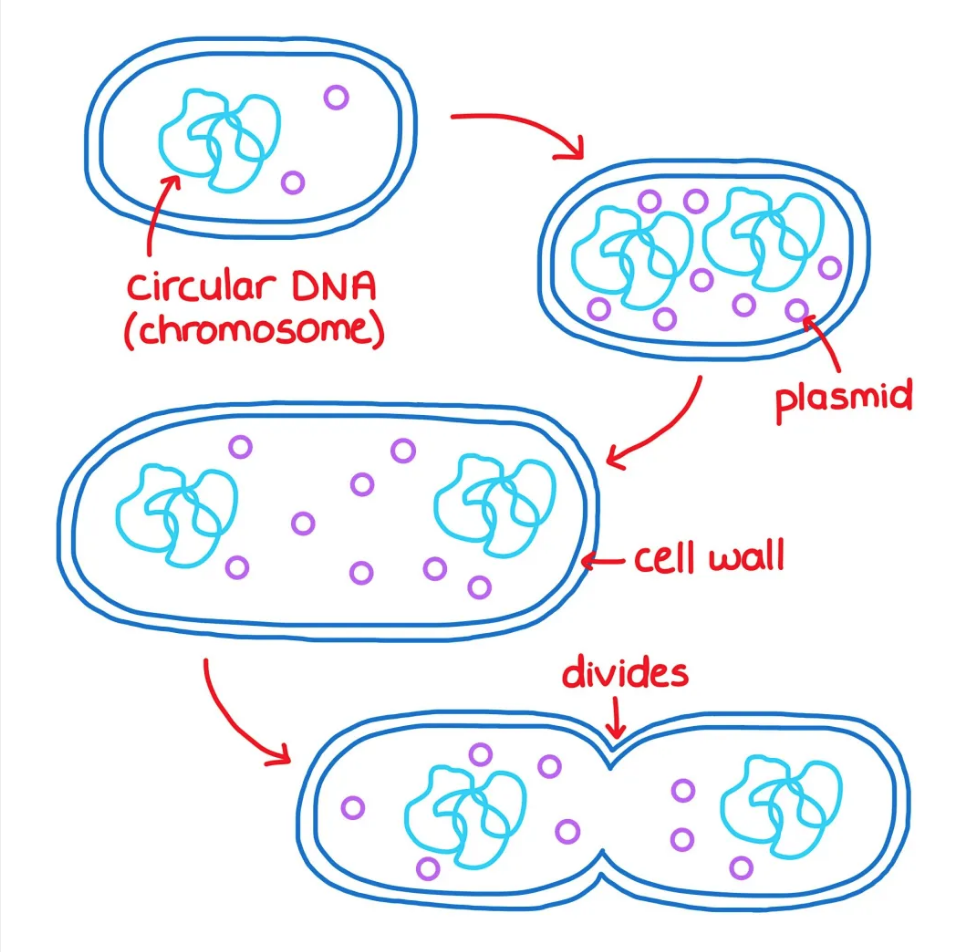
68
New cards
What are the 3 stages of the cell cycle?
1. Interphase (G0, G1, S, G2)
2. Mitosis (PMAT)
3. Cytokinesis
69
New cards
What is the centromere?
Links a pair of sister chromatids
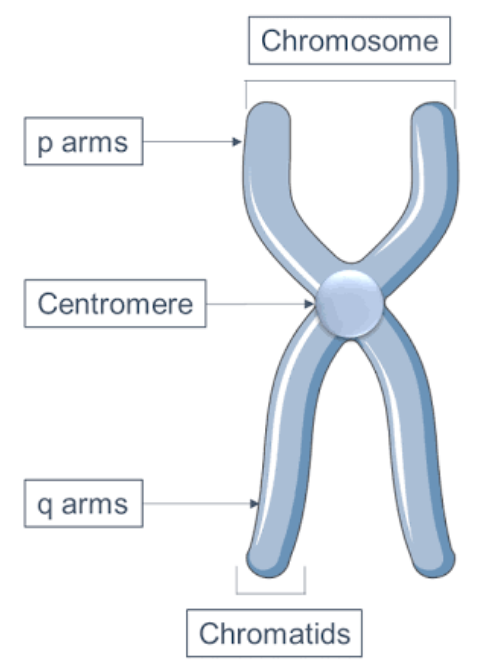
70
New cards
What is a chromatid?
One half of a replicated chromosome
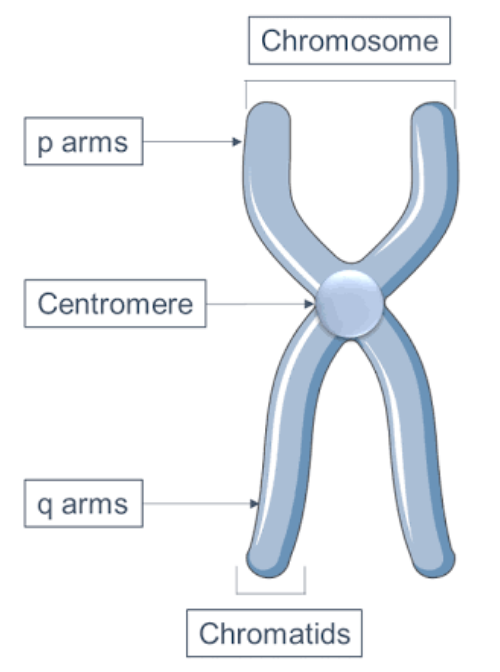
71
New cards
What does the centriole do?
It produces spindle fibres
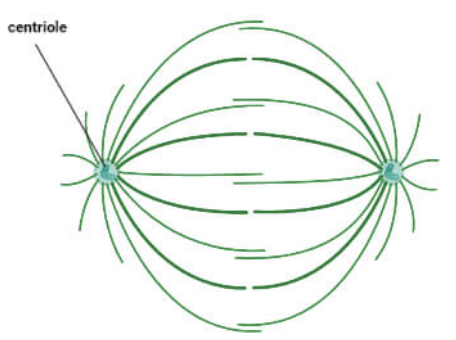
72
New cards
What happens in the G0 stage of the cell cycle?
Resting state for non-dividing cells
73
New cards
What happens in the G1 stage of the cell cycle?
Growth of the cytoplasm and organelles
74
New cards
What happens in the S stage of the cell cycle?
DNA synthesis
75
New cards
What happens in the G2 stage of the cell cycle?
* Mitochondria and ATP synthesis
* Cell ‘double checks’ the duplicated chromosomes for errors and makes any necessary repairs
* Cell ‘double checks’ the duplicated chromosomes for errors and makes any necessary repairs
76
New cards
What are the 4 stages of mitosis?
**P**rophase
**M**etaphase
**A**naphase
**T**elophase
**M**etaphase
**A**naphase
**T**elophase
77
New cards
What happens during prophase?
* Chromosomes condense and become visible
* Centriole divides and moves to opposite poles of the cell
* Nucleolus becomes less prominent
* Nuclear envelope disintegrates
* Centriole divides and moves to opposite poles of the cell
* Nucleolus becomes less prominent
* Nuclear envelope disintegrates

78
New cards
What happens during metaphase?
* Each centriole is at a pole
* Centrioles produce spindle fibres
* Spindle fibres attach to the centromere of the chromosomes
* Chromosomes line up at the equator
* Centrioles produce spindle fibres
* Spindle fibres attach to the centromere of the chromosomes
* Chromosomes line up at the equator
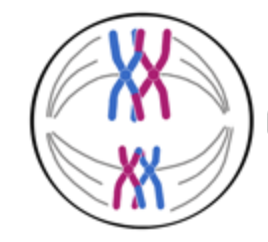
79
New cards
What happens during anaphase?
* Spindle fibres contract (requiring ATP)
* Chromatids are pulled to opposite poles of the cell
* Chromatids are pulled to opposite poles of the cell
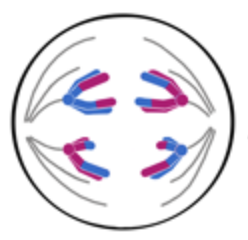
80
New cards
What happens during telophase?
* Chromatids reach the poles of the spindle
* Chromatids begin to uncoil and become less distinct
* Nuclear envelope starts to reform
* Chromatids begin to uncoil and become less distinct
* Nuclear envelope starts to reform
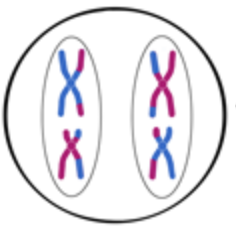
81
New cards
What happens during cytokinesis?
The cell divides
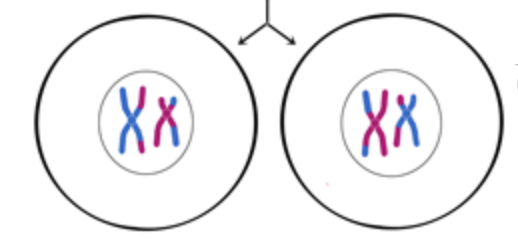
82
New cards
Why do cells need to divide?
To produce new cells
* For growth
* For replacement of old/damaged cells
To reproduce
* Asexual reproduction (cloning)
* Sexual reproduction (gametes)
* For growth
* For replacement of old/damaged cells
To reproduce
* Asexual reproduction (cloning)
* Sexual reproduction (gametes)
83
New cards
What are the steps to finding how much time a cell spends in mitosis?
1. Find total number of cells
2. Work out number of cells in specific stage as a percentage of the total
3. Work out time spent in that stage by calculating same percentage of 24 hours
4. Convert answer to minutes and hours if necessary
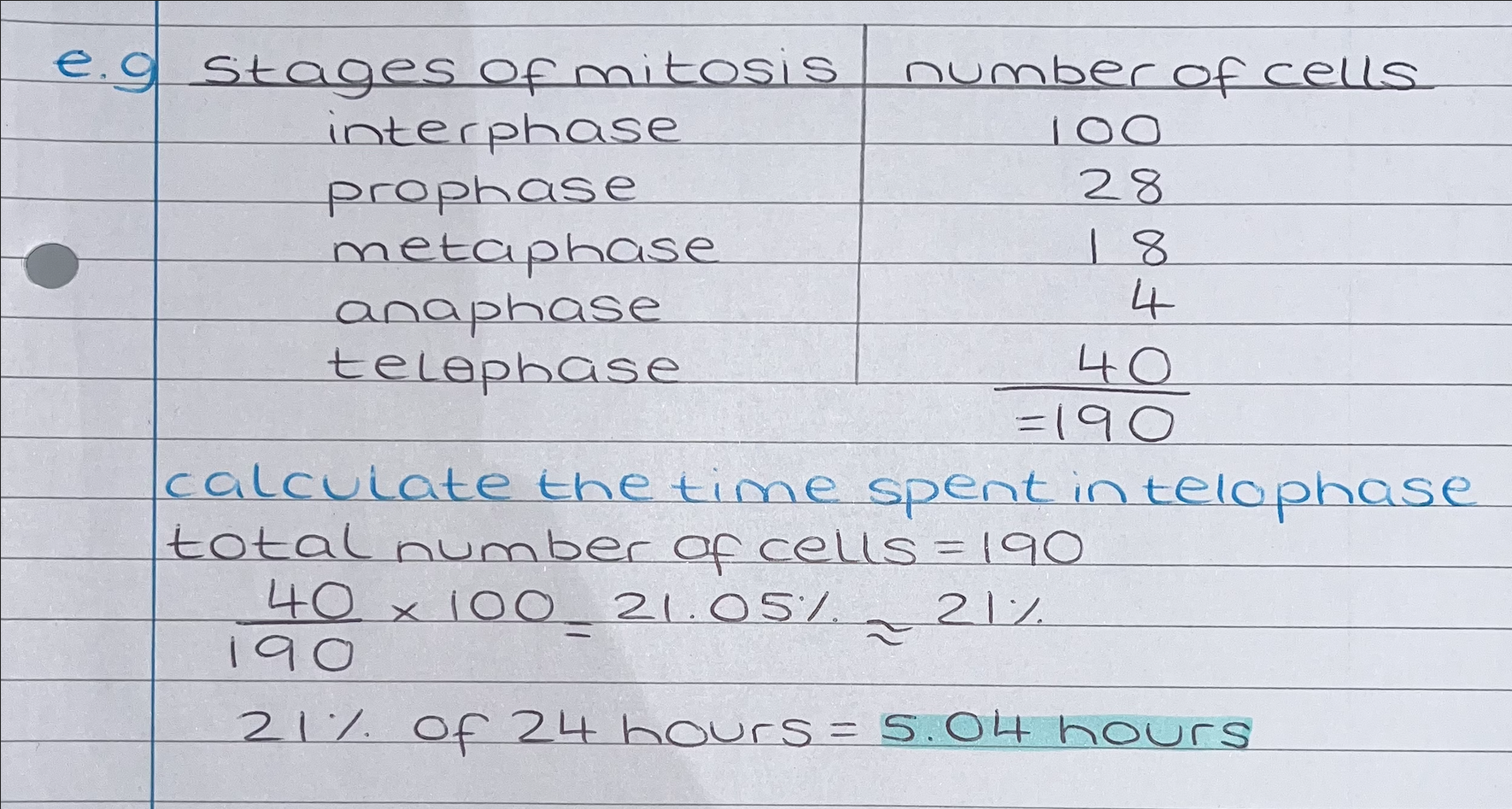
84
New cards
What is the equation to calculate mitotic index?
Cells undergoing mitosis ÷ total number of cells
85
New cards
What form will a mitotic index be in?
Percentage or decimal
86
New cards
What is a virus?
Non-living structures which consist of one or more strands of genetic material (DNA or RNA) surrounded by a protein coat (capsid).
87
New cards
What structures is a HIV virus made up of?
* Attachment protein
* Lipid envelope
* Matrix
* Capsid
* DNA/RNA
* Reverse transcriptase (enzyme)
* Lipid envelope
* Matrix
* Capsid
* DNA/RNA
* Reverse transcriptase (enzyme)
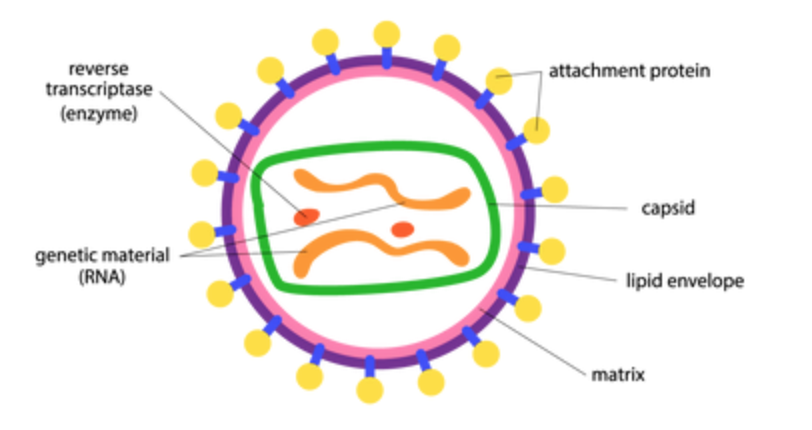
88
New cards
How does HIV replicate after entering a human cell?
1. HIV attaches to the complementary proteins on the surface of the helper T-cell and the virus enters the cell.
1. Reverse transcriptase converts the viral DNA to RNA.
2. This DNA is then joined into the DNA of the host cell.
3. When the host cell divides the DNA is used to make copies of HIV RNA.
4. The HIV capsid (protein) and enzymes and made by host cell ribosomes.
5. Everything is assembled by the host cells RER and golgi apparatus into new virus particles.
6. These are packaged into vesicles and ‘budding off’ occurs (viruses are wrapped in a membrane).
89
New cards
Why are antibiotics ineffective against viruses?
They prevent chains/bonds being made in the cell walls but since viruses do not have cell walls they do not work.